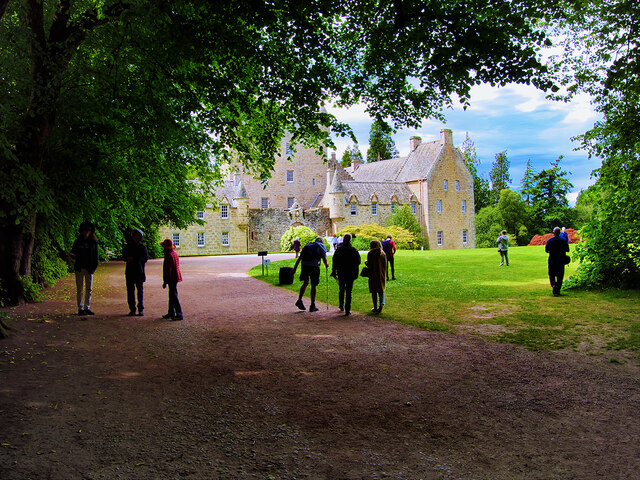Cawdor Castle
Heritage Site in Nairnshire
Scotland
Cawdor Castle

Cawdor Castle, located in Nairnshire, Scotland, is a well-preserved medieval fortress that holds significant historical and cultural importance. This heritage site is situated near the village of Cawdor, approximately 10 miles east of Inverness. Built around a 15th-century tower house, the castle is surrounded by picturesque gardens and woodland, creating a breathtaking setting.
The castle's origins date back to 1370, when it was constructed as a private fortress by the Thanes of Cawdor. Over the centuries, several additions and alterations have been made, resulting in a unique blend of architectural styles, including Gothic, Jacobean, and Georgian. Despite these changes, the castle has managed to retain its original character.
Cawdor Castle is renowned for its association with Shakespeare's play, Macbeth, though the castle itself was built long after the events of the play took place. Nevertheless, the connection has attracted visitors from around the world who are intrigued by the castle's association with this famous literary work.
Inside, visitors can explore the castle's opulent interiors, which are adorned with intricate tapestries, antique furniture, and an impressive collection of artwork. The castle also houses a fascinating museum that showcases historical artifacts, including ancient weapons, armor, and personal belongings of the Cawdor family.
The castle's grounds are equally captivating, featuring beautifully manicured gardens, a walled garden, and a nature trail that winds through the surrounding woodland. The gardens offer a tranquil environment that contrasts the castle's imposing exterior, providing visitors with an opportunity to relax and enjoy the natural beauty of the surroundings.
Today, Cawdor Castle stands as a testament to Scotland's rich history and architectural heritage, attracting visitors who are eager to immerse themselves in the castle's captivating past.
If you have any feedback on the listing, please let us know in the comments section below.
Cawdor Castle Images
Images are sourced within 2km of 57.522/-3.928 or Grid Reference NH8449. Thanks to Geograph Open Source API. All images are credited.





Cawdor Castle is located at Grid Ref: NH8449 (Lat: 57.522, Lng: -3.928)
What 3 Words
///districts.fended.waking. Near Nairn, Highland
Nearby Locations
Related Wikis
Cawdor Castle
Cawdor Castle is a castle in the parish of Cawdor in Nairnshire, Scotland. It is built around a 15th-century tower house, with substantial additions in...
Cawdor
Cawdor (Scottish Gaelic: Caladair) is a village and parish in the Highland council area, Scotland. The village is 5 miles (8 kilometres) south-southwest...
Culcharry
Culcharry is a small residential settlement, close to the village of Cawdor and the hamlet of Brackla, lying 4 miles southwest of Nairn, in Nairnshire...
Clephanton
Clephanton is a small hamlet 2 miles south-east from Ardersier and 7 miles south-west of Nairn in Inverness-shire, Scottish Highlands. It is in the Scottish...
Nearby Amenities
Located within 500m of 57.522,-3.928Have you been to Cawdor Castle?
Leave your review of Cawdor Castle below (or comments, questions and feedback).












